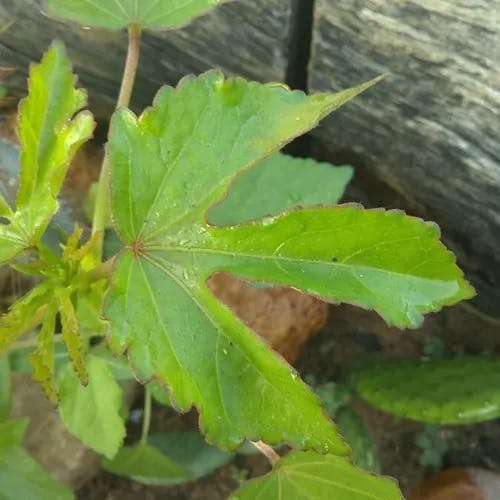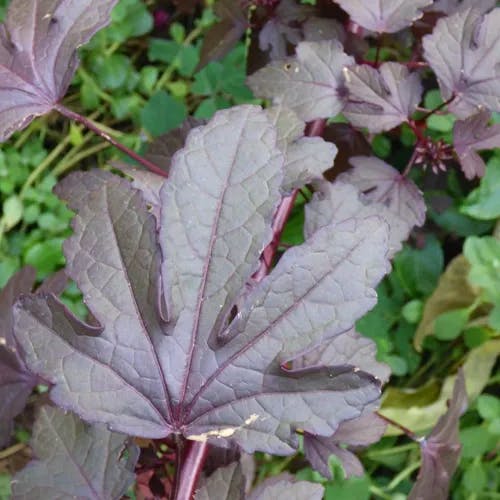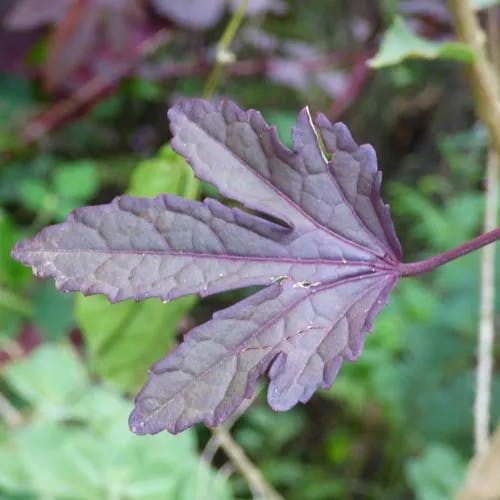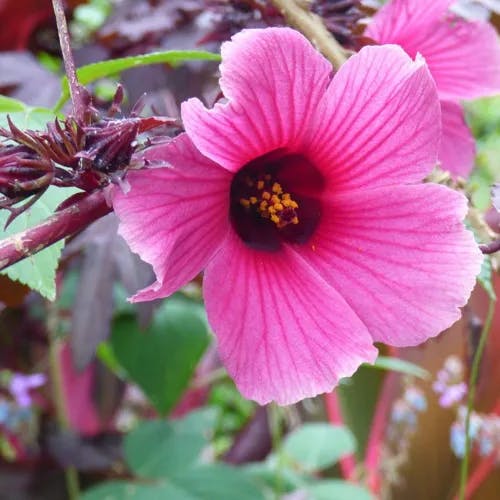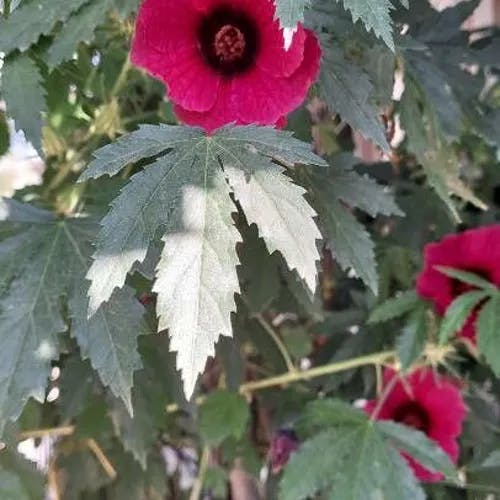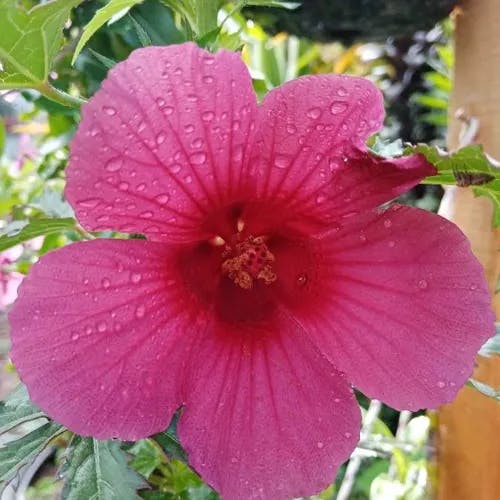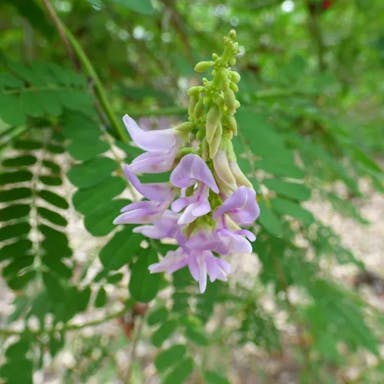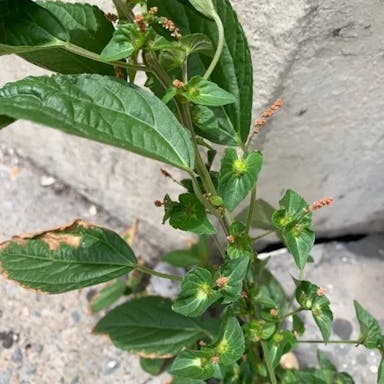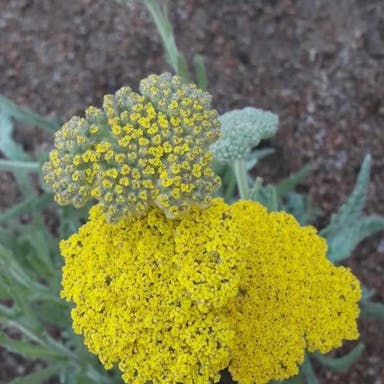The flowering shrub Hibiscus acetosella, sometimes called red sorrel or false roselle, is a tropical plant belonging to the mallow family. It grows up to six feet tall and produces large, colorful blooms in shades of red, pink, and purple throughout the warm season.These eye-catching flowers attract bees, butterflies, and other pollinators. The maple-shaped leaves have a tangy flavor and can be eaten raw in salads or cooked. This perennial plant is very drought-tolerant once established and requires little care in the garden. It thrives in areas with full sun exposure. Hibiscus acetosella grows well from seeds or cuttings. Pruning will keep it shapely and promote more abundant blooms. This easy-care African native adds vibrant color and unique foliage to the landscape.
False roselle
- Scientific name
- Hibiscus acetosella
Basic Information
- Malvaceae Family Hibiscus Genus False roselle Species
- Malvaceae > Hibiscus > Hibiscus acetosella
- 83%
- The Completeness of This Encyclopedia
Please help us complete the encyclopedia, Terrarium is a encyclopedia service to be completed with everyone in the world. Currently, this page is 83% complete. For more information on how to contribute, please click here.
- Forb/herb
- Shrub
- Height
- 150cm ~
- Flower Color
- Leaf Color
- Anthesis
- summer, fall
- Sunlight Exposure
Full Sun Long hours of sunlight from morning to afternoon Partial Shade A location in the shade of a tree or where either the morning or afternoon is shaded Full Shade A place where there is no direct sunlight
- Full Sun
- Hardiness Zones
This is an indicator to know to which zone each plant can winter. Knowing the zone of each plant gives you an idea of the cold temperature resistance when grown in the ground without a roof. 2: -42.7 to -40.0 3: -39.9 to -34.4 4: -34.3 to -28.9 5: -28.8 to -23.3 6: -23.2 to -17.8 7: -17.7 to -12.2 8: -12.1 to -6.7 9: -6.6 to -1.1 10: -1.0 to 4.4 11: 4.5 to 10.0
- 9
- Cold resistance
- Fair
- Heat resistance
- Excellent
- Habitat of origin
- Africa
- Growth Rate
- Fast
What is False roselle (Hibiscus acetosella)?
What is False roselle (Hibiscus acetosella)
Flower meaning
The crimson False roselle flower which has the scientific name Hibiscus acetosella lacks an agreed upon symbolic meaning in American flower language. While some blossoms convey special messages based on culture, False roselle's significance differs between eras and countries.
Calendar of False roselle (Hibiscus acetosella)
Calendar
The flowering season of the plant known as False roselle or Hibiscus acetosella ordinarily starts at the conclusion of springtime or the beginning of summertime in America and proceeds until the initial frost arrives in autumn. Its vividly colored blossoms tend to be most picturesque during the peak of summer, typically in the months of July and August. The precise duration of bloom time is contingent on particular growing circumstances, however generally endures for a number of weeks. Removing faded blooms can assist to lengthen the flowering period. Offering adequate sunlight, hydration and nutrients also promotes prolonged blossoming. With its unique blooms and leaves, False roselle contributes vibrant tones to gardens in the summer. It is appreciated both for ornamental and edible plantings.
How to grow False roselle (Hibiscus acetosella)
Watering
The plant called False roselle and known as Hibiscus acetosella needs water at regular intervals to grow well. Watering the False roselle once every 2-3 days while it is growing is optimal. How often to water can change based on the temperature, humidity, and type of soil. It is important that the soil stays evenly moist but not soggy. Too much water can cause root rot and other problems, so checking the soil moisture is crucial. In the dormant season, water only once every 7-10 days since the plant needs less water then. Morning or evening are recommended times to water False roselle to limit evaporation and allow the plant to absorb water. Checking the soil moisture routinely and adjusting the watering calendar accordingly will help the False roselle stay healthy and energetic.
Soil and Fertilizer
The false roselle is a plant that prefers fertile, damp soil with a somewhat acidic pH level. It thrives in loam, which provides an excellent balance of sand, silt, and clay. To promote vigorous growth, the false roselle requires periodic feeding with a balanced fertilizer during the growing season. Applying an excessive amount of fertilizer can promote leafy growth rather than flowers. It is best to follow the recommended dosage for the plant's size and age. Testing the soil regularly allows adjusting the fertilizer amounts as needed. The false roselle is a beautiful plant, but proper care is needed for it to reach its full potential.
Sunlight and Place
The plant Hibiscus acetosella, scientifically termed False roselle, flourishes with complete sunlight. It endures both cold and heat excellently, making it appropriate for diverse climates. Ideal temperatures for False roselle range from 70-85°F (21-29°C). However, it survives temperatures as low as 40°F (4°C) and up to 100°F (38°C). In the summer, situate False roselle where it gets no less than 6-8 hours of direct sunlight daily for best growth and blooming. Regarding sunlight intensity, False roselle handles intense sunlight without issues. In winter, since False roselle is frost-intolerant, it can be kept indoors or in a greenhouse. Ensure adequate sunlight during this time, either through a bright window or grow lights.
Advanced Information of False roselle (Hibiscus acetosella)
Pruning
The flowering plant Hibiscus acetosella benefits from routine trimming. Trimming helps maintain its form, encourages healthy development, and prevents overgrowing. It also eliminates perished or impaired stems, refining its whole appearance. The optimal time to trim this plant is early springtime, preceding the emergence of new growth. This facilitates quick recovery and stimulates vigorous growth throughout the season. When trimming, use sterilized, sharp tools for clean cuts and minimize disease transmission risks. To trim, firstly remove any expired or infected branches. Then, selectively cut back any overgrown or lanky branches to retain a compact, bushy shape. Attempt to eliminate no more than one-third of total growth to avoid stress. Subsequently, properly dispose of debris to halt disease spread. Additionally, providing adequate hydration and nutrients will aid recovery and stimulate new growth. Routine trimming will ensure a vigorous, attractive Hibiscus acetosella.
Planting and Harvest
The scientific name for false roselle is Hibiscus acetosella. This plant can be grown indoors in a pot or outside in the ground. When planting false roselle in a container, choose one with drainage holes that is at least 12 inches wide. Use a quality potting mix and plant at the same level as before. Water thoroughly after planting. Keep the soil moist but not saturated. Place the pot where it gets 6+ hours of sunlight daily. Feed with a balanced fertilizer every 4-6 weeks. Repot into a larger pot if it outgrows the current one. Insufficient care can slow growth, discolor leaves, and lead to pests. Monitor the plant closely and adjust care as needed.
Propagation
The genus Hibiscus of the mallow family, Hibiscus acetosella also identified as Roselle, possesses several types of propagation. Propagation by seed, cuttings, division, and leaf cuttings characterize potential methods. To propagate by seed, allow seed pods to fully mature on the plant. Remove seeds from pods and plant immediately in well-draining soil. Maintain consistent moisture and filtered sunlight. Expect germination within 7-14 days. Propagation by division requires carefully separating the Roselle plant into smaller sections with roots attached to each portion. Plant divided sections separately in containers or directly in the ground. Supply adequate hydration and sunlight. Stem cuttings 4-6 inches in length taken from nodes on the stems allow for propagation. Strip leaves from lower half of each cutting and dip cut end in rooting hormone. Place cutting in potting mix formulated for drainage and keep in warm humid setting. Rooting takes 14-28 days. For leaf cuttings, remove healthy leaves and cut into smaller sections. Plant each leaf piece in potting mix with drainage, keeping moist and situating in indirect sunlight. New plantlets generate from leaf cuttings in approximately 3 weeks. After the plant matures and desired portions like leaves or flowers develop, harvest carefully without harming the plant. Proper care when collecting leads to sustained health and prolonged harvesting.
Pests and Diseases
The False roselle plant, also called Hibiscus acetosella, can be affected by various insects and fungi. Small aphids suck the sap, making the plant grow slowly and turn yellow. Tiny spider mites also drain the juice of the leaves, making them wilt and fade in color. A white powder called powdery mildew can cover the leaves, stems and flowers, so good air flow is needed. Too much water can rot the roots and make the whole plant wither. To keep the False roselle healthy, check it regularly for pests, water correctly, and use things like soapy water or neem oil to prevent problems.
Habitat of False roselle (Hibiscus acetosella)
Habitat
Toxicity of False roselle (Hibiscus acetosella)
Health Benefits
- edible
- edible
- Toxic
- No toxicity
NO DATA
Toxic for dogs and cats
NO DATA
Q&A of False roselle (Hibiscus acetosella)
- Is there a recommended way to choose Hibiscus acetosella?
The Malvaceae family's plant Hibiscus acetosella, often called False roselle, presents choices in cultivars for both ornamental and practical uses. Hardy varieties useful as outdoor plants with showy foliage include 'Red Shield' and 'Cranberry Crush', the latter valued in container gardening for its compact growth habit and dark foliage. For edible leaves, 'African Sunset' gives a tangy flavor for salads or tea. Purchase viable, fresh seeds from suppliers with good reputations. Starting seeds indoors before frost allows a head start on the growing season. When transplanting, pick vigorous, healthy seedlings and dodge any with signs of problems. Careful choices in varieties, seeds, and plants lead to triumph cultivating these attractive Hibiscus.
